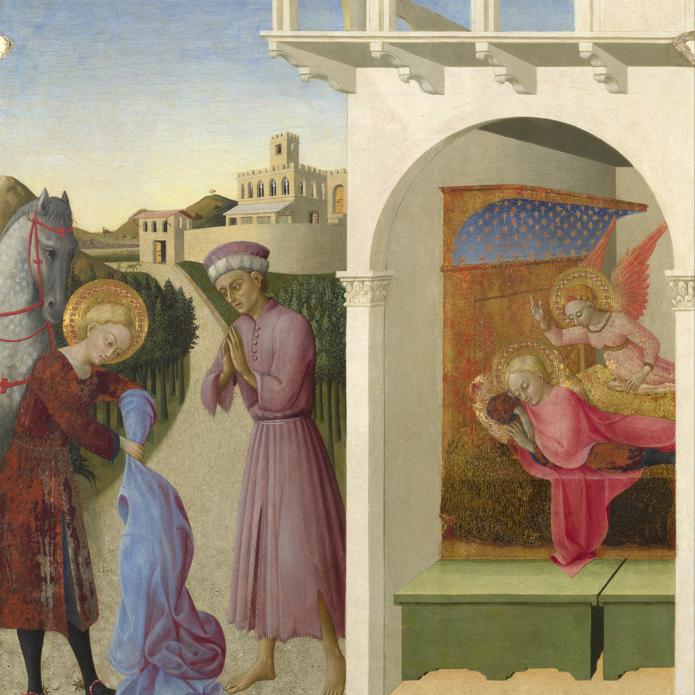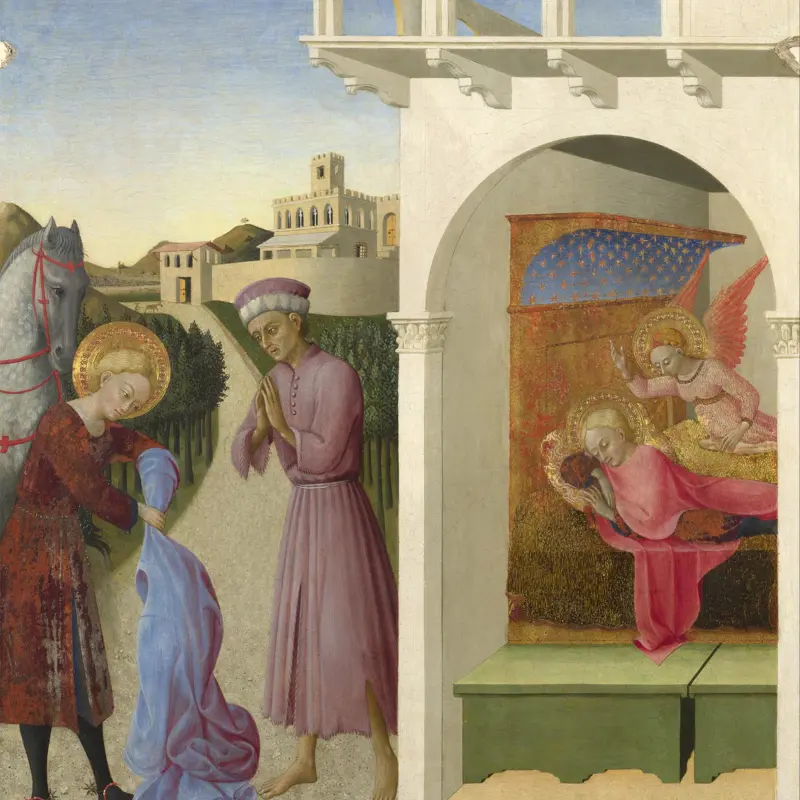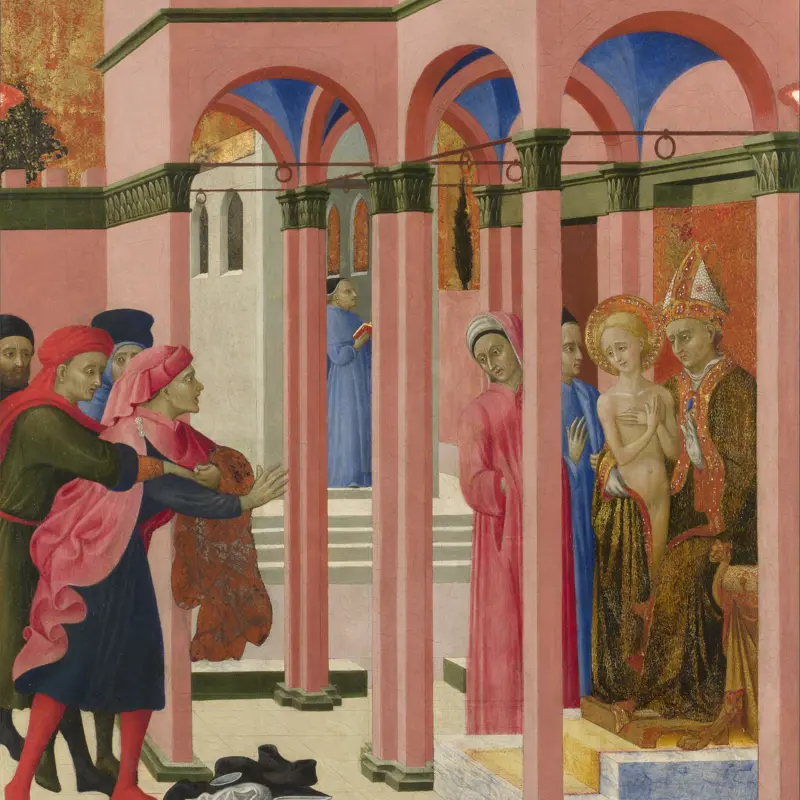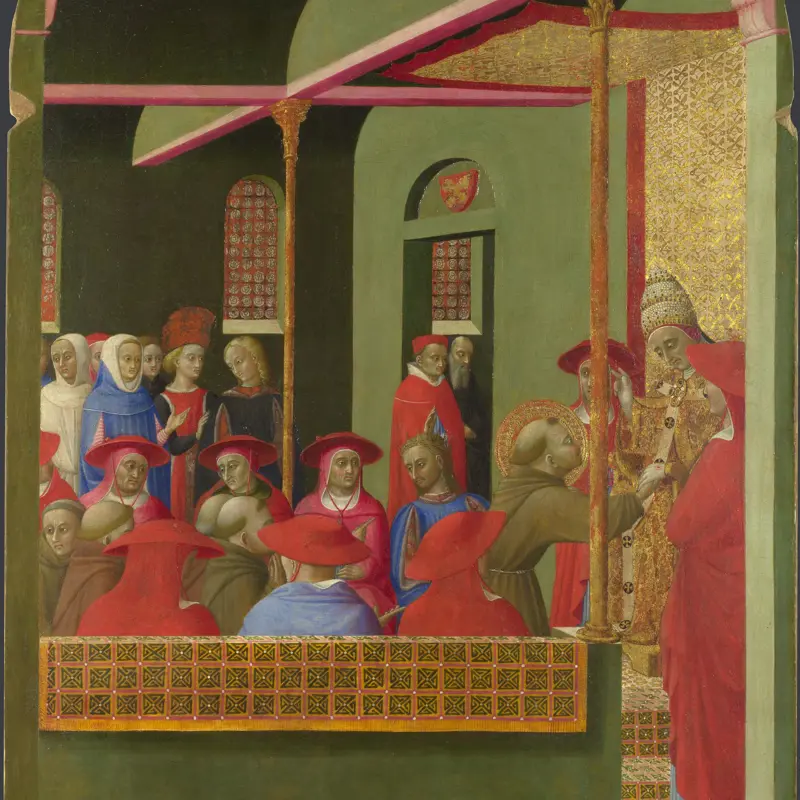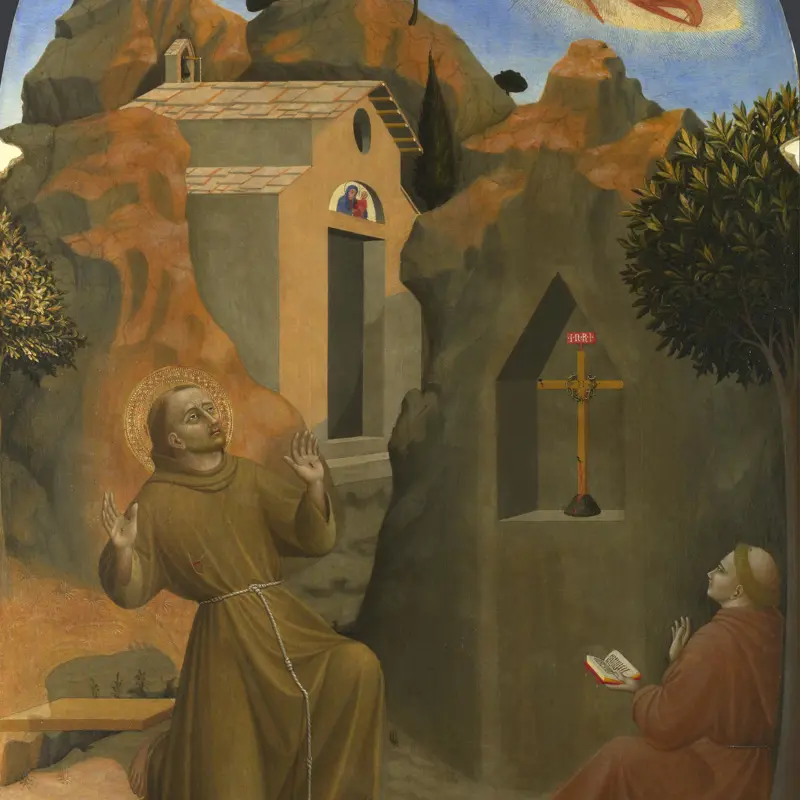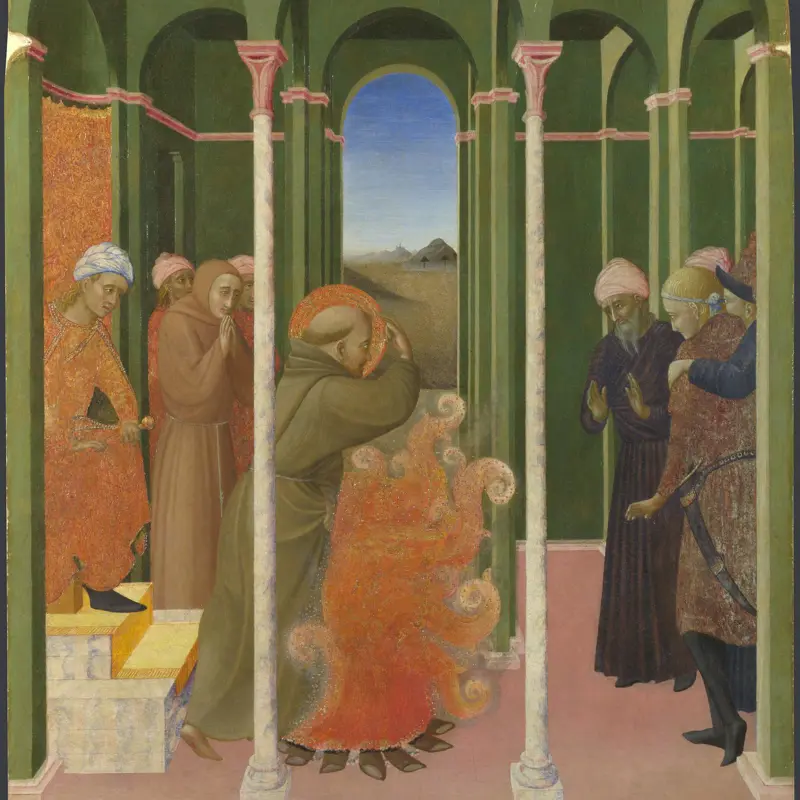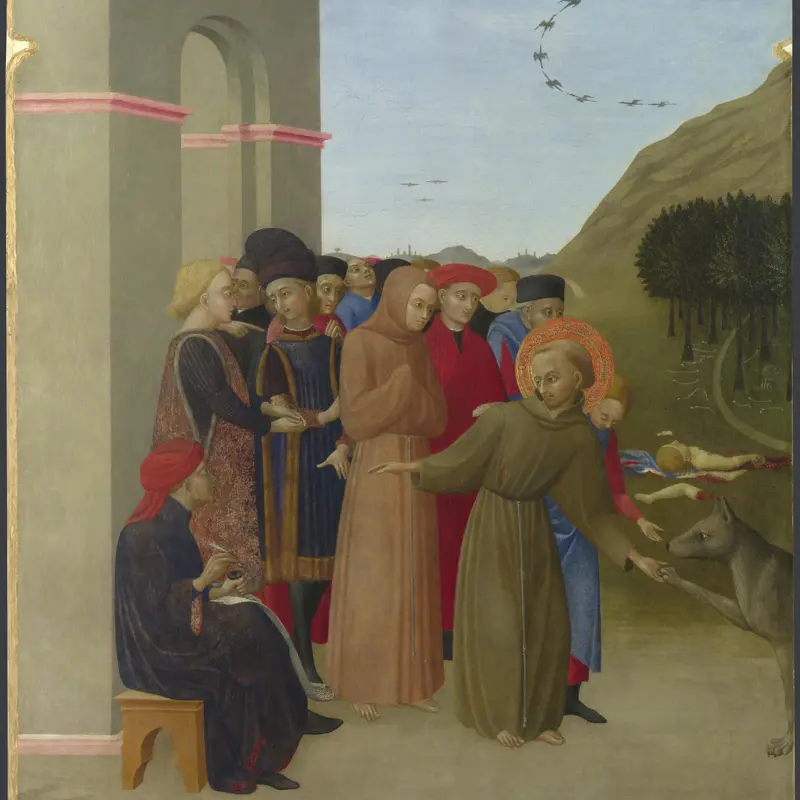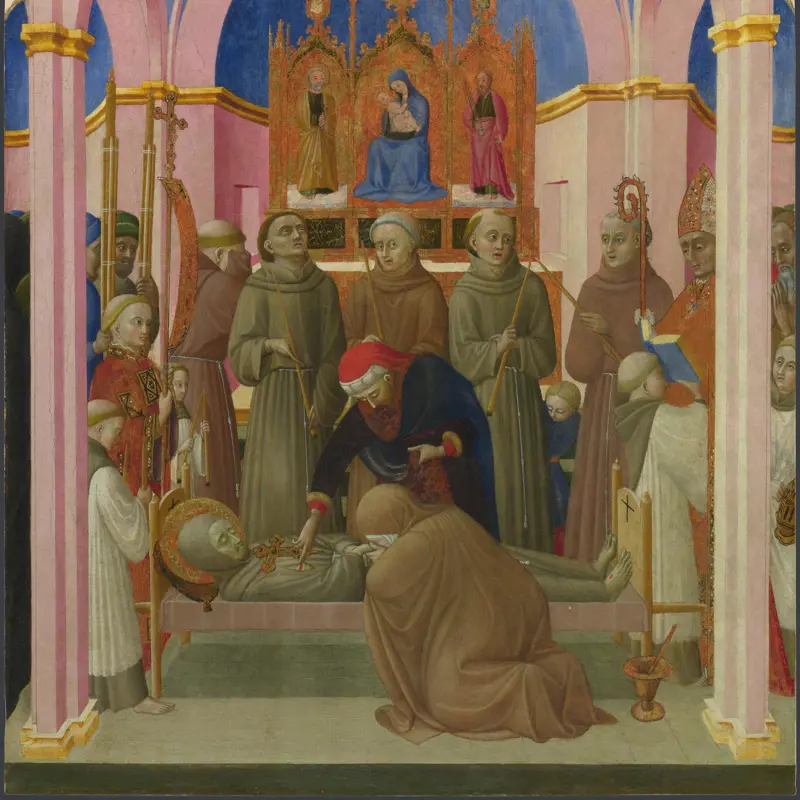Sassetta, 'Saint Francis and the Poor Knight, and Francis's Vision', 1437-44
About the work
Overview
According to his biography, the young Saint Francis of Assisi, the son of a wealthy merchant, gave his expensive clothes to a poor knight. The next night God sent him a vision of a great palace, and promised it to him and his soldiers (that is, the army of Franciscan friars he was to found). This the first of eight paintings from the back of an elaborate double-sided altarpiece by Sassetta, which was one of the outstanding artistic commissions of fifteenth-century Italy.
The theme of poverty and its rewards runs through the altarpiece, perhaps encouraged by the stringent attitudes of the Observant (reformed) Franciscans, who attracted many followers at this time. Francis’s elegant dress contrasts vividly with the knight’s ragged clothes: his spurs are silver and his robe is silver, painted over with a red lake glaze. The richness of his home is emphasised by the use of gold for the bedhead, cover and pillow.
Key facts
Details
- Full title
- Saint Francis meets a Knight Poorer than Himself and Saint Francis's Vision of the Founding of the Franciscan Order
- Artist
- Sassetta
- Artist dates
- active by 1427; died 1450
- Part of the series
- San Sepolcro Altarpiece
- Date made
- 1437-44
- Medium and support
- egg tempera on wood
- Dimensions
- 87 × 52.5 cm
- Acquisition credit
- Bought with contributions from the Art Fund, Benjamin Guinness and Lord Bearsted, 1934
- Inventory number
- NG4757
- Location
- Room 58
- Collection
- Main Collection
- Frame
- 21st-century Replica Frame
Provenance
Additional information
Text extracted from the ‘Provenance’ section of the catalogue entry in Dillian Gordon, ‘National Gallery Catalogues: The Fifteenth Century Italian Paintings’, vol. 1, London 2003; for further information, see the full catalogue entry.
Exhibition history
-
2023Saint Francis of AssisiThe National Gallery (London)6 May 2023 - 30 July 2023
Bibliography
-
1877'Exposition rétrospective de Lyon', Gazette des beaux-arts, 1877, pp. 265-79
-
1888J.B. Giraud, Memorial Volume on the Lyons Exhibition of 1877 (exh. cat. Lyons, 1888), Lyons 1888
-
1898S. Borghesi and L. Banchi, Nuovi documenti per la storia dell'arte senese, Siena 1898
-
1901G. Milanesi, Nuovi documenti per la storia dell'arte Toscana, Florence 1901
-
1901A. Venturi, Storia dell'arte italiana, 11 vols, Milan 1901
-
1903J.A. Crowe and G.B. Cavalcaselle, A History of Painting in Italy, Umbria, Florence and Siena, from the Second to the Sixteenth Century, ed. R.L. Douglas, 2nd edn, 6 vols, London 1903
-
1903B. Berenson, 'A Sienese Painter of the Franciscan Legend, II', The Burlington Magazine, III/8, 1903, pp. 171-84
-
1903B. Berenson, 'A Sienese Painter of the Franciscan Legend, I', The Burlington Magazine, III/7, 1903, pp. 3-35
-
1903R.L. Douglas, 'A Forgotten Painter', The Burlington Magazine, I/3, 1903, pp. 306-18
-
1903R.L. Douglas, 'A Note on Recent Criticism of the Art of Sassetta', The Burlington Magazine, III/9, 1903, pp. 265-75
-
1905G. Migeon, 'La collection de M. G. Chalandon', Les Arts, 42, 1905, pp. 17-29
-
1923R. van Marle, The Development of the Italian Schools of Painting, 19 vols, The Hague 1923
-
1925A. Venturi, Grandi artisti italiani (celebrazioni e tributi), Bologna 1925
-
1935National Gallery, National Gallery and Tate Gallery Directors' Reports, 1934, London 1935
-
1935K. Clark, 'Seven Sassettas for the National Gallery', The Burlington Magazine, LXVI/385, 1935, pp. 153-4
-
1939J. Pope-Hennessy, Sassetta, London 1939
-
1945T. Bodkin, Dismembered Masterpieces: A Plea for Their Reconstruction by International Action, London 1945
-
1948B. Berenson, Sassetta: Un peintre siennois de la légende franciscaine, Paris 1948
-
1951Davies, Martin, National Gallery Catalogues: The Earlier Italian Schools, London 1951
-
1951E. Carli, 'Sassetta's Borgo San Sepolcro Altarpiece', The Burlington Magazine, XCIII, 1951, pp. 145-53
-
1957E. Carli, Sassetta e il Maestro dell'Osservanza, Milan 1957
-
1960M. Laclotte, 'Sassetta, le Maître de l'Observance et Sano di Pietro: Un problème critique', Information d'historire de l'Art, V, 1960, pp. 47-53
-
1967R. Longhi, Saggi e ricerche, 1925-1928, Florence 1967
-
1968B. Berenson, Italian Pictures of the Renaissance: A List of the Principal Artists and Their Works, with an Index of Places: Central Italian and North Italian Schools, revised edn, 3 vols, London 1968
-
1972M. Baxandall, Painting and Experience in Fifteenth Century Italy: A Primer in the Social History of Pictorial Style, Oxford 1972
-
1974H.W. van Os, 'St. Francis of Assisi as a Second Christ in Early Italian Painting', Simiolus, VII/3, 1974, pp. 115-32
-
1977J. Mills and R. White, 'Analyses of Paint Media', National Gallery Technical Bulletin, I, 1977, pp. 57-9
-
1977M. Wyld and J. Plesters, 'Some Panels from Sassetta's Sansepolcro Altarpiece', National Gallery Technical Bulletin, I, 1977, pp. 3-17
-
1978A. Braham, 'Reconstructing Sassetta's Altarpiece', The Burlington Magazine, CXX/903, 1978, pp. 386-90
-
1980C. Gilbert, Italian Art, 1400-1450: Sources and Documents, Englewood Cliffs 1980
-
1980P. Scapecchi, 'La rimozione e lo smembramento della pala del Sassetta di Borgo San Sepolcro', Prospettiva, 20, 1980, pp. 57-8
-
1986Davies, Martin, National Gallery Catalogues: The Earlier Italian Schools, revised edn, London 1986
-
1986L. Bellosi and A. Angelini, Sassetta e i pittori toscani tra XIII e XV secolo, (exh. cat. Palazzo Chigi-Saracini, 1986), Florence 1986
-
1988K. Christiansen, Gothic to Renaissance: European Painting 1300-1600, London 1988
-
1988J.K. Lydecker, The Domestic Settings of the Arts in Renaissance Florence, Ann Arbor 1988
-
1988M.A. Pavone, Iconologia francescana: Il Quattrocento, Todi 1988
-
1988D. Thiébaut, 'Sassetta tel un puzzle', Connaissance des arts, CDXXXIV, 1988, pp. 48-54
-
1988D. Thiébaut, 'Un nouveau tableau de Sassetta au Louvre', Revue du Louvre, XXXVIII/2, 1988, pp. 153-4
-
1988K. Christiansen, L. Kanter and C.B. Strehlke, Painting in Renaissance Siena 1420-1500 (exh. cat. Metropolitan Museum of Art, 20 December 1988 - 19 March 1989), New York 1988
-
1989G. Saunders, The Nude: A New Perspective, London 1989
-
1990H.W. van Os, Sienese Altarpieces 1215-1460: Form, Content, Function: 1344-1460, vol. 2, 1344-1460, Groningen 1990
-
1990J.R. Banker, 'Un documento inedito del 1432 sull'attività di Piero della Francesca per la chiesa di San Francesco in Borgo San Sepolcro', Rivista d'arte, XLII, 1990, pp. 245-7
-
1990F. Lambert, 'Pour une sémiologie des fins de la peinture: Deux tableaux de Sassetta', in R. Démoris (ed.), Les fins de la peinture, Paris 1990
-
1990D. Thiébaut, 'Sassetta', in M. Laclotte et al. (eds), Polyptyques: Le tableau multiple du moyen âge au vingtième siècle, Paris 1990, pp. 79-84
-
1991J. Dunkerton et al., Giotto to Dürer: Early Renaissance Painting in the National Gallery, New Haven 1991
-
1991M.B. Hall, Colour and Meaning: Practice and Theory in Renaissance Painting, Cambridge 1991
-
1991J.R. Banker, 'The Program for the Sassetta Altarpiece in the Church of S. Francesco in Borgo S. Sepolcro', I Tatti Studies, IV, 1991, pp. 11-58
-
1992L. Berti, Nel raggio di Piero: La pittura nell'Italia centrale nell'età di Piero della Francesca (exh. cat. Casa di Piero, 11 July -31 October 1992), Venice 1992
-
1993D. Gordon, 'The Reconstruction of Sassetta's Altarpiece for S. Francesco, Borgo San Sepolcro, a Postscript', The Burlington Magazine, CXXXV/1086, 1993, pp. 620-3
-
1993V. Garibaldi, Piero della Francesca: Il polittico di Sant'Antonio (exh. cat. Sala della Cannoniera, Rocca Paolina, 18 May - 30 September 1993), Perugia 1993
-
1995E.H. Gombrich, Shadows: The Depiction of Cast Shadows in Western Art (exh. cat. The National Gallery, 26 April - 18 June 1995), London 1995
-
1998B. David, 'Pope-Hennessy, Derrida, and "Literary Residue" in Visual Images: The Case of Sassetta's Borgo San Sepolcro Altarpiece', Studies in Iconography, XIX, 1998, pp. 1-30
-
1999C. Gardner von Teuffel, 'Niccolò di Segna, Sassetta, Piero della Francesca and Perugino: Cult and Continuity at Sansepolcro', Städel-Jahrbuch, XVII, 1999, pp. 163-208
-
2001
C. Baker and T. Henry, The National Gallery: Complete Illustrated Catalogue, London 2001
-
2001D. Cooper, 'Franciscan Choir Enclosures and the Function of Double-Sided Altarpieces in Pre-Tridentine Umbria', Journal of the Warburg and Courtauld Institutes, LXIV, 2001, pp. 1-54
-
2001D. Cooper, 'Spinello Aretino in Città di Castello: The Lost Model for Sassetta's Sansepolcro Polyptych', Apollo, LIV/474, 2001, pp. 22-9
-
2003Gordon, Dillian, National Gallery Catalogues: The Fifteenth Century Italian Paintings, 1, London 2003
-
2005M. O'Malley, The Business of Art: Contracts and the Commissioning Process in Renaissance Italy, New Haven 2005
-
2005C. Gardner von Teuffel, From Duccio's 'Maestà' to Raphael's 'Transfiguration': Italian Altarpieces and Their Settings, London 2005
-
2005D. Cooper, 'Le tombe del Beato Ranieri a Sansepolcro e del Beato Giacomo a Città di Castello: Arte e santità Francescana nella terra altotiberina prima di Sassetta', in F. Polcri (ed.), Il Beato Ranieri nella Storia del Francescanesimo e della Terra Altotiberina, Sansepolcro 2005, pp. 103-33
-
2006K. Toyama, 'The Headless Cast Shadow: Cast Shadows in 15th Century Sienese Painting and the Case of Sassetta's Stigmatization of Saint Francis', Zeitschrift für Kunstgeschichte, LXIX/4, 2006, pp. 531-9
-
2008G. Fattorini, 'Quattrocentisti senesi tra l'alta Valle del Tevere e la Val di Chiana', in L. Fornasari et al. (eds), Arte in terra d'Arezzo: Il Quattrocento, Florence 2008, pp. 77-98
-
2009R. Billinge, '"Some Panels from Sassetta's Sansepolcro Altarpiece" Revisited', National Gallery Technical Bulletin, XXX, 2009, pp. 8-25
Frame
This reproduction tabernacle frame was made at the National Gallery for the Saint Francis of Assisi exhibition in 2023. It draws inspiration from the frame on Sassetta’s Pala della Madonna della neve (Galleria degli Uffizi, Florence). Meticulously crafted from poplar wood, it is water-gilt with decorative motifs adorning the pilasters and the predella. Within the gilded Romanesque arched frames, incised trefoils in the spandrels are painted in a blue hue. Doric capitals adorn the frames and, along with the pilasters, are embellished with undulating foliage engraved into the gesso. The predella features sgraffito ornamentation.
Saint Francis and the Poor Knight, and Francis’s Vision, one of eight panels from the high altarpiece of S. Francesco in Borgo Sansepolcro, Italy, originally formed a double-sided polyptych. Remarkably, all eight panels share a surviving frame, albeit in parts. In 1935 seven of the panels were detached from their original frames and entrusted to the firm G.P. Coulette, which crafted single frames.
About this record
If you know more about this work or have spotted an error, please contact us. Please note that exhibition histories are listed from 2009 onwards. Bibliographies may not be complete; more comprehensive information is available in the National Gallery Library.
Images
About the series: San Sepolcro Altarpiece
Overview
These paintings were once part of one of the largest and most splendid altarpieces of the early Italian Renaissance. Made up of almost 60 panels, the double-sided altarpiece was painted for the high altar of San Francesco in Borgo San Sepolcro, a town near Arezzo. The back, which was seen primarily by the friars, showed Saint Francis in glory surrounded by eight scenes of his life, seven of which are in the National Gallery’s collection.
Unusually, surviving documents tell us a lot about how it was commissioned, constructed and paid for. The project was begun in 1426 but had foundered, and in September 1437 Sassetta took over. In early 1439 two friars visited him in Siena, bringing the scripta, a document stating what he was to depict. Although they provided the text, the artist provided the imagination: the scripta states that the friars, themselves artisans, and the painter together should decide on the details.

